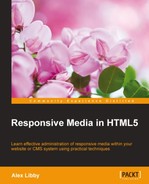Book Description
Learn effective administration of responsive media within your website or CMS system using practical techniques
In Detail
Rapid growth in the use of mobile devices to access the Internet has forced designers to adapt to creating content that is easily viewable on a wide range of different devices. The key is to make images and videos responsive to the platform used, enabling them to be resized automatically when displayed on mobile devices or desktops.
This book is a fast-paced, hands-on guide that shows you how to apply some simple techniques to add images and video content to your site, which may be a simple, one-page portfolio, or a complex content management system. The book starts with showing you how to display images. You will learn about browser support and different platforms, and alternatives for high- and low-resolution images. Moving on, the book covers techniques to add responsive video content. You will get to know about adding images and videos and test the media using online sites and tools. The book also explains the use of plugins and responsive frameworks.
What You Will Learn
- Add responsive images and video content to your site
- Understand some of the pitfalls of mixing responsive images and videos, and how to alter your development to ensure both co-operate together
- Incorporate responsive media in popular frameworks such as WordPress, Less CSS, and Bootstrap
- Test responsive sites to ensure content displays correctly on different iOS and Android devices
- Discover how to make allowances for mobile devices, and use tools to improve speed of access
- Utilize tools such as YSlow and other online tools to determine speed of the sites
- Employ preloaders to counter delays in loading
Downloading the example code for this book. You can download the example code files for all Packt books you have purchased from your account at http://www.PacktPub.com. If you purchased this book elsewhere, you can visit http://www.PacktPub.com/support and register to have the files e-mailed directly to you.
Table of Contents
- Responsive Media in HTML5
- Table of Contents
- Responsive Media in HTML5
- Credits
- About the Author
- About the Reviewers
- www.PacktPub.com
- Preface
- 1. Working with Responsive Images
- Getting started
- Beginning with fluid images
- Catering to vendor prefixes and image formats
- Catering to different platforms
- Catering to HD or retina images
- Using sprites to display responsive images
- Determining the available viewport for use
- Working out media queries
- Using pure JS to determine page breakpoints
- Using data tags to allow bandwidth constraints
- Working with the <picture> tags
- Working with the SVG image format for scalability
- Using image icons for scalability
- Building a responsive carousel
- Creating responsive maps using Google Maps
- Summary
- 2. Adding Responsive Video Content
- Getting ready
- Determining support for <video> formats
- Choosing the right format
- Embedding HTML5 video content
- Determining an available viewport for use
- Catering to fallback support
- Using JS libraries to provide support
- Catering to different platforms
- Allowing for vendor prefixes
- Displaying full-size videos
- Summary
- 3. Mixing Content
- 4. Testing Responsive Media
- 5. Using Frameworks
- Index
